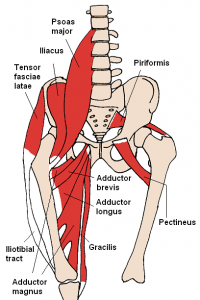Athletic Injuries 101: Snapping Hip Syndrome
 Dr. Sarah Ytsma explains another athletic injury, this time taking a look at snapping hip syndrome.
Dr. Sarah Ytsma explains another athletic injury, this time taking a look at snapping hip syndrome.
Definition & Discussion:
“Snapping Hip Syndrome” is a recurrent, perceivable (sometimes even audible) click or snap in the hip during active movement involving the hip. It may occur during weight bearing like running or walking or non weight bearing. Benign, painless snapping is common.
There are 4 common types of snapping hip:
- Lateral/External: This is the most common type. This occurs when the Iliotibial Band (ITB), a tight band that runs from the bony protrusion on the hip, to the outside of the knee, catches and snaps on the greater trochanter itself (the bony prominence)
- Anterior/Internal: This is also a very common type. This occurs when the iliopsoas (hip flexor muscles) catches on a portion of the head of the femur (thigh bone) or the front of the hip joint capsule. This can also result from a ligament that attaches the ilium (the hip bone) to the femoral head.
- Posterior: Rare occurrence. This happens when the bicep femoris tendon (one of the hamstring muscles) catches or rubs along the edge of the ischial tuberosity (the bones we sit on).
- Intra-Articular: This means within the hip joint itself, and is due to a loose body (cartilage fragment), labum tear, recurring subluxation or dislocation of the hip.
Risk Factors of Snapping Hip Syndrome:
- A hip that moves too much/instability (more common in females) — very common in dancers and gymnasts
- An increase in the curve in the lumbar spine (i.e. buttock sticks out more)
- Leg length asymmetry or one foot pronating more than the other
- Running in the same direction on a banked surface (i.e. roadside or a track )
- A thickened tendon or scar tissue following injury
- Anatomical irregularity
- Hip replacement or scarring from other hip surgeries/injuries
- Muscle imbalances –> Weak outer thigh muscles (abductors), tight gluteals and inner thigh muscles, weak abdominals, hamstrings and hip flexors, tight quads
- Spine, pelvic, or lower extremity joint dysfunction
Signs & Symptoms of Snapping Hip Syndrome:
- Pain & snapping of the hip with active motion
- Snapping of the hip can be reproduced by the doctor, depending on the suspected type of snapping hip.
- Neurological – lateral snapping of the hip can refer pain down the side of the thigh, or down the front of the thigh if it is impinging the femoral nerve.
- Inflammation of the hip’s fat pad may occur
- Leg length discrepancy – usually occurs on the side of the long leg
- Weak hip flexors and increased curve in the low back.
Management of Snapping Hip Syndrome:
- the cause of the problem must be first address (i.e. stretch the tight muscle, level out the pelvis, correct the foot, etc…)
- Hot packs over the muscle or ultrasound
- Massage therapy/myofascial release
- Manipulate/mobilize the hip joint, spine and pelvis
- Stretching the involved muscle
- Correct the leg length problem if necessary (orthotics if needed)


